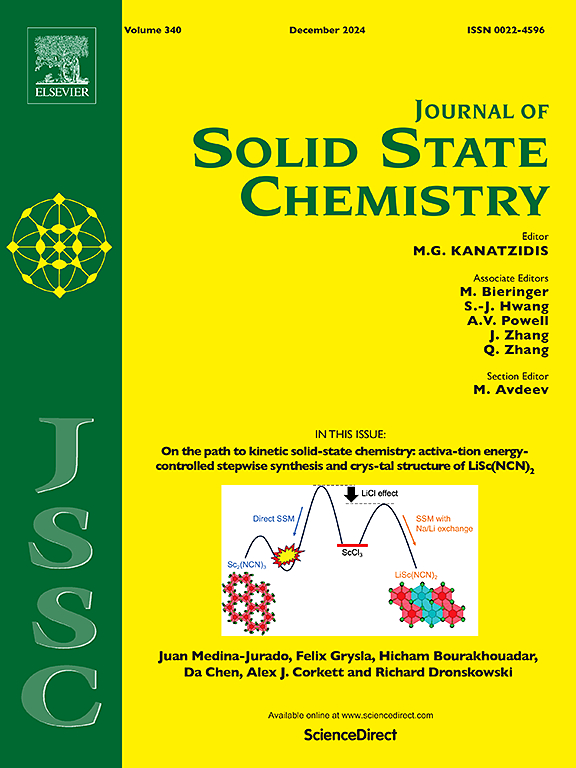离子液体卤化物阴离子掺入MAPbI3钙钛矿的策略缺陷钝化
IF 3.5
3区 化学
Q2 CHEMISTRY, INORGANIC & NUCLEAR
引用次数: 0
摘要
钙钛矿材料作为钙钛矿太阳能电池的吸光材料得到了广泛的应用。不良的薄膜形貌,晶体缺陷和小晶粒尺寸,严重影响其性能和稳定性,导致电荷复合和次优光电性能。为了解决这些挑战,我们在甲基碘化铅(MAPbI3)钙钛矿组合物中加入了五种离子液体(il)来进行缺陷钝化。所有il都有相同的咪唑阳离子,但卤化物阴离子不同。考虑卤化物阴离子(F >;Cl祝辞Br祝辞I),我们期望il可以与钙钛矿材料相互作用,增强其形态和晶体稳定性。此外,il中的咪唑有望与欠配位的Pb形成配位共价键。本研究系统地研究了离子液体(IL)掺入对钙钛矿薄膜结晶度、形貌和光电性能的影响,并利用一系列技术实现了缺陷钝化。值得注意的是,当添加10%的1-丁基-3-甲基咪唑碘化物(BMIM[I])时,得到了最特殊的结果,在黑暗环境条件下(75%相对湿度)50天后,晶粒生长(885 nm),薄膜覆盖率(98.74%)最大,形貌更光滑,晶粒尺寸最大(69.97 nm),紫外吸收保持率最高。FTIR证实了IL卤素基阴离子与MAPbI3之间的相互作用。XRD分析表明,PbI2整体结晶度较高,且完全转化为钙钛矿。紫外-可见结果表明,所有il的吸收增强,带隙变化很小。光致发光(PL)分析表明,BMIM[I]处理的薄膜具有最高的PL强度,表明缺陷辅助复合减少。本文章由计算机程序翻译,如有差异,请以英文原文为准。

Strategic defect passivation through halide anion incorporation from ionic liquids in MAPbI3 perovskites
Perovskite materials are widely used as promising light absorption materials for perovskite solar cells. Poor film morphology, with crystal defects and small grain sizes, significantly impacts their performance and stability, causing charge recombination and suboptimal optoelectronic properties. To address these challenges, we incorporate five ionic liquids (ILs) for defect passivation in methylammonium lead iodide (MAPbI3) perovskite compositions. All ILs share the same imidazolium cation but vary in halide anions. Considering the electronegativity trend of halide anions (F > Cl > Br > I), we expect that ILs could interact with the perovskite material, enhancing its morphology and crystal stability. Furthermore, the imidazolium of ILs is expected to form coordinate covalent bonds with under-coordinated Pb. This study systematically investigates the influence of ionic liquid (IL) incorporation on the crystallinity, morphology, and optoelectronic properties of perovskite films using a range of techniques, thereby achieving defect passivation. Notably, the most exceptional results are obtained by adding 10 % 1-Butyl-3-methylimidazolium iodide (BMIM[I]), which demonstrates substantial grain growth (885 nm), maximum film coverage (98.74 %), a smoother morphology, maximum crystallite size (69.97 nm) and the highest UV absorption retention after 50 days under dark ambient conditions (75 % relative humidity). FTIR confirms the interaction between IL halide-based anions and MAPbI3. XRD analysis indicates overall higher crystallinity and complete conversion of PbI2 to perovskite. UV–Vis results show enhanced absorption with a little change in the bandgap for all ILs. Photoluminescence (PL) analysis shows that BMIM[I]-treated films exhibit the highest PL intensity, indicating reduced defect-assisted recombination.
求助全文
通过发布文献求助,成功后即可免费获取论文全文。
去求助
来源期刊

Journal of Solid State Chemistry
化学-无机化学与核化学
CiteScore
6.00
自引率
9.10%
发文量
848
审稿时长
25 days
期刊介绍:
Covering major developments in the field of solid state chemistry and related areas such as ceramics and amorphous materials, the Journal of Solid State Chemistry features studies of chemical, structural, thermodynamic, electronic, magnetic, and optical properties and processes in solids.
 求助内容:
求助内容: 应助结果提醒方式:
应助结果提醒方式:


